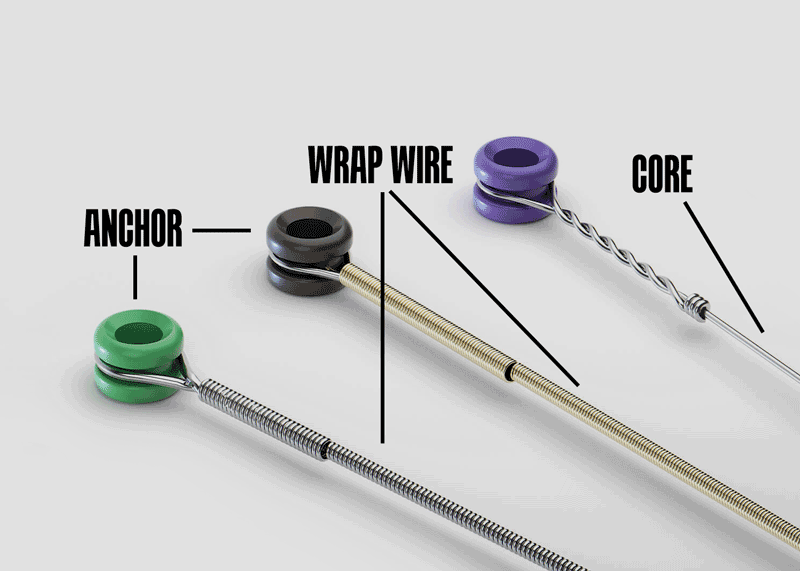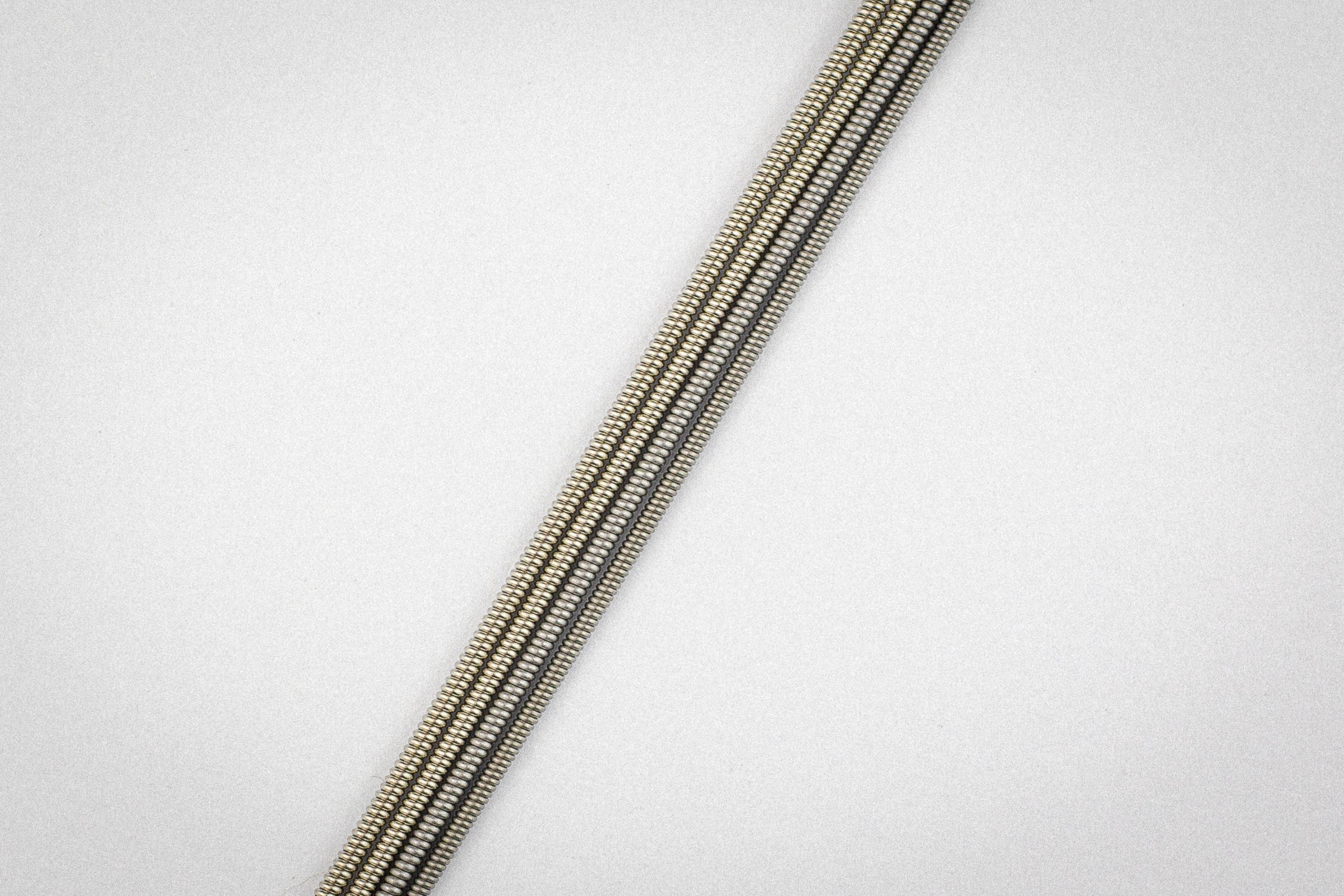Which Guitar Strings to Buy
The Ultimate Guide for Acoustic, Electric, Classical & Basses!
HOW TO CHOOSE GUITAR STRINGS
When you’re able to find your perfect set of guitar strings you’ll completely transform your playing experience. Progressing from just ‘any old set the guy in the guitar store gave you’ to a set of strings specifically to fit your guitar and playing style will speed up your improvement while making the whole process more enjoyable. So, the right set of strings will allow you to get the most out of your guitar, got it, but where to start? It’s easy to be baffled by the vast array of options when you don’t even have a clue what you’re after.
So, here’s the definitive guide to all aspects of the guitar string. Whether you’re literally just starting out, or have been playing for 50-years there’ll be some good takeaways for you below. Let’s get stuck in…
ANATOMY OF A GUITAR STRING

Right, firstly, what are the components of a guitar string?
- core
- anchor
- winding
- coating
STRING CORE
As the word suggests, this is the heart of every guitar string. There are a few different types and/or shapes of core.
HEX CORE
Electric/Acoustic/Bass | Bright | Stable
The most common core type is the hexagonally-shaped ‘hex’ core which has six flat sides and is made from high-carbon steel. This is favoured for its strength, rigidity, stability and its six points of grip for the wrap wire.
ROUND CORE
Electric/Acoustic/Bass | Warm | Flexible
The original electric guitar strings core-type. Again, made with high-carbon steel, however the round core has a little more mass at any given gauge which provides a warmer, deeper inherent tone. Compared to hex core the round core strings tend to be larger to provide the same strength and stability while being more flexible.
NYLON
Classical/Acoustic| Warm | Soft
Nylon cores are made from stranded filaments of nylon or blended synthetic fibres. As you’d expect compared to the steel cores above they have much lower tension and far more flexibility and a very warm tone.
ROPE
Acoustic | Warm | Flexible
A very specialist type of core which is made from woven steel wire which is very flexible and thick-sounding.
SILK & STEEL
Acoustic | Warm | Most Flexible
A round steel core is combined with ‘silk’ or synthetic rayon which gives the strings lots of flexibility and provides a very warm tone.
STRING CONSTRUCTION
String construction is the term we use for both the winding technique and profile of the wrap wire used on guitar strings. If you look closely at the thickest guitar strings you’ll see that the outer wire probably looks round and cylindrical. This is what is called ‘round wound’ and is by far the most popular and widely used winding; however, there are a quite a few more and we’ve outlined them below:

ROUND WOUND
As afore mentioned, this is the most popular winding construction used in guitar strings. A smooth, round wire is wrapped around the core either in a single layer or multiple layer for bigger strings. In general this type of winding produce a bright sound with a lot of clarity.
FLAT WOUND
Providing the darkest and most mellow tone, flatwound strings are made using a flat wrap wire which is usually further ground or polished once wound to produce a completely flat string. The added bonus is the elimination of finger ‘squeak’ when moving up and down the strings, if that bugs you.
HALF ROUND & GROUND WOUND
These terms (even semi-round) are generally interchangeable although certain manufacturers will argue their processes are different… . These strings start with a round wrap wire which is then precision ground to take the top off the windings. This process retains a lot of the brightness of round wound strings but with a smoother feel.
TAPE WOUND
Tape winding is most popular in bass guitar and upright bass strings. This utilises a flat ribbon (or tape) of nylon that is wrapped around a steel core. Sometimes there’ll be a winding of steel wire underneath this too. The sound is warm, and rich with a muted top-end.
ANCHOR

The anchor is the point at which the string is fixed to your guitar or instruments. Many instruments require different anchors.
BALL-END (aka metal doughnut)
The most common and versatile type of anchor point, this is a small ball of brass with a hole through the centre (resembling a doughnut) at the end of a guitar string. It’s designed to sit in a ferrule/cup or hardtail bridge.
LOOP-END
Used predominantly for folk instruments this is a small steel loop which is designed to go over the hooks at the end of your instrument.
DOUBLE-BALL
Alike ball-end strings but anchored at both ends. These are designed for headless guitars or basses with a Steinberger (or similar) system which has a fixed string length.
WRAP MATERIAL
We’re talking specifically about the thicker, wound strings in any set here. You’ll probably know already (but have a look if you don’t) that guitar strings sets are composed of a mixture of wound and plain (non-wound) strings. This wrap wire is one of the most crucial tonal elements of the string and below we’ll outline the most popular. Sets are generally defined by the type of wrap material used.

NICKEL-PLATED STEEL (NPS)
This is the most common of all types of electric guitar and bass wrap wire. As the name suggests it’s made with a steel wire that’s plated with nickel. The tone is bright, clear, versatile, and modern. The flagship ranges of most brands use NPS wrap wire.
PURE NICKEL
This is literally close-to-pure nickel wire. The tone is bright, but inherently warmer than the nickel-plated steel version. Pure nickel strings are used to recreate a more ‘vintage’ or ‘darker’ tone still with good clarity but smoother in overall sound.
STAINLESS STEEL
Very bright, coarser to touch and innately long-lasting. Stainless steel strings produce a more aggressive, bright, and focused tone with tight low-end response and slightly higher output.
PHOSPHOR BRONZE
This is the most popular of the acoustic guitar alloys. Made from a mix of 92% copper and about 8% tin (and sometimes a little phosphorous). This alloy was first used for guitar strings by D’Addario in the 70’s for its natural longevity. The tone is warm and full with a nice amount of clarity.
80/20 BRONZE
80/20 bronze is an alloy of roughly 80% copper and 20% zinc. It has a bright, articulate, percussive, and loud sound with a controlled low-end punch. 80/20 bronze strings are the 2nd most popular of the acoustic guitar strings alloys, and especially favoured for giving life back to inherently dark or old guitars.
MONEL
Monel strings are available for both electric and acoustic guitar and consist of a relatively evenly mixed nickel:copper alloy. This vintage, pre-war material is a nickel-based alloy and it’s key features are a soft feel, longevity and a warm but crucially, uncoloured sound. These strings really let a guitar show itself off.
STRING GAUGE
Just one of those fragments of the past that’s forever here to stay… (that’s using imperial instead of metric). String gauge comes from wire gauge and is the literal overall diameter of the string in thousandths of an inch. We use it in its shortened form dropping the ‘0.0’ instead referring to a string of gauge 0.010” as a ’10’.
Strings sets are denoted by their thinnest and thickest gauges. For example, a set of 10, 13, 17, 26w, 36w, 46w will be written as ’10-46’ and then further colloquially referred to as ‘a set of 10s’.
STANDARD GAUGES
There are a few sets of strings for specific instruments that are broadly referred to as standard gauges. Each brand will have their own twist on comparative gauge.
ELECTRIC GUITAR
There are three standard gauges for electric guitar which are: 9-42 (light), 10-46 (regular), and 11-49/50 (medium).
ACOUSTIC GUITAR
There are two popular gauges for acoustic guitar, these are: 11-52 (custom light), and 12-53 (light).
BASS GUITAR
When it comes to bass there a couple of standard 4-string gauges, and a 5-string: 40-100 (light), 45-105 (regular), and 5-string 40-125 (light).
HYBRID & ALTERNATIVE GAUGES
Outside of the standard gauges mentioned above there are myriad of alternate sets to cater for almost any instrument, tuning, and playing style. To keep this simple, we’ll layout a few options for you. For electric guitar riffers, shredders and those who like to play in drop-D we suggest using light-top/heavy-bottom sets such as 10-52 or 9-46. If you play acoustic you may like to try a ‘Bluegrass’ set of 12-56.
Regardless of instrument, if you’re planning on down tuning then it’s best practice to increase the gauge of the whole set. A very basic rule of thumb for guitar is to go up a whole gauge for each full tone you drop.
COATING
String coating was a dark art that was ousted by purists and professionals for a long time, until the early nought-ies when there were some significant advances in technology. Now coated and treated strings are widely used. There are currently a few different types of coatings, treatments, and methods used to achieve longer tone-life.
POLYMER COATINGS
Generally the most popular type of strings coating is a complete covering; using a polymer film tube/sheath the whole string is covered/coated completely. Versions of this process are used by Elixir and D’Addario XS and are widely regarded as the most robust type of coating. They’re also the most conspicuous, although some brands will say that their coating feels most like a natural (uncoated) string.
TREATMENTS
Strings treatments are usually chemical and have anti-rust, hydrophobic, or other similar properties.
CORE/WIRE COATING
As you can now imagination, there will always be a brand or range that bucks the trend. In this respect, there are ranges of strings that only coat the core, or only the wire, or treat one part and coat the other. These strings are often thought of as the best of both worlds.
Coatings and treatments can completely change the feel of any strings and many players actually prefer the feel of coated strings over normal strings. Something you won’t know until you try…
SCALE LENGTH
Scale length is twice the distance from the inside of the top nut to the centre of the twelfth fret - or more commonly (for ease and rough calculation) the distance between the nut and the bridge saddle. Scale length can have a drastic effect on tone, feel, and tuning of your guitar and, as such, is essential to think about when choosing strings.
24.75”/25.5”
There are generally two widely used scale lengths for electric guitar. The most favoured is the 25.5” (aka Fender) scale length which provides the most accurate intonation across all strings. The other is a 24.75” scale length used for Les Paul-style guitars, gives lower tension and a fuller, richer tone but can sometimes be more tricky to tune ‘perfectly’ (a further word on this below). The shorter scale requires less tension to get to the same pitch, so to achieve a similar tension it’s advisable to increase the set gauge as the scale length gets shorter. For example, where a Strat will normally take 10s, a Les Paul would feel similar/better with 11s.bass guitars
Basses are available in at least four scale lengths! And this can catch many players out. Bass strings are so thick that they need to taper down to the core when they approach the machine heads. The most obvious issue with buying the wrong scale strings is that the taper will start too soon (before the nut) or too late (won’t fit through the tuner post) resulting in a poorly playing set. It’s vital to check your bass before and here’s how to do it (we also have this article in every bass strings listing).
Scale length, tuning, and intonation can never be perfect, and nor should they be. Although Western music has been rigidly quantising all pitch and rhythm to a greater and greater extent, world and Eastern music uses a far richer palette of tones and pitches. Just think, would MJ’s vocals and Slash’s solos be as universally popular if they’d been ‘perfectly’ in tune?
Which guitar strings to buy
So, with everything above in mind let’s give you a few good sets to start with. Although we say ‘start with’ you may in fact never change, and that’s fine. Angus Young hasn’t… (Ernie Ball 9-42 Super Slinky).
Best strings to buy for electric guitar
Where to start with electric guitar strings? We suggest light to regular gauge 9-42 or 10-46 sets. Something with a nickel-plated steel wrap wire and hex core.
Best strings to buy for ACOUSTIC guitar
Where to start with acoustic guitar strings? We suggest custom light to light gauge 11-52 or 12-53 sets. Something with a phosphor bronze wrap wire and hex core.
Best strings to buy for ELECTRIC BASS guitar
Where to start with bass guitar strings? Firstly, you must work out what length of strings your bass needs; once you know that you can select your set. For the majority of basses we suggest 40-100 or 45-105 mid-weight sets.
Best strings to buy for semi-acoustic guitars and folk instruments
Ah man, no idea. The word ‘Folk’ strikes fear into the hearts of most musicians. Haha. Seriously though… . When choosing strings for your folk instrument you’ll need to know whether it’s going to be amp’d or mic’d. For most it’ll be acoustic and you’ll need bronze strings, and keep the weight light-medium.
Best strings to buy for CLASSICAL guitar
For the most part we suggest medium to hard tension strings on classical guitars. Although the instrument is generally thought of as a good starting place for guitar players for its soft feel using low tension strings can actually be more difficult to play and hinder your progression.
I hope that makes sense!
